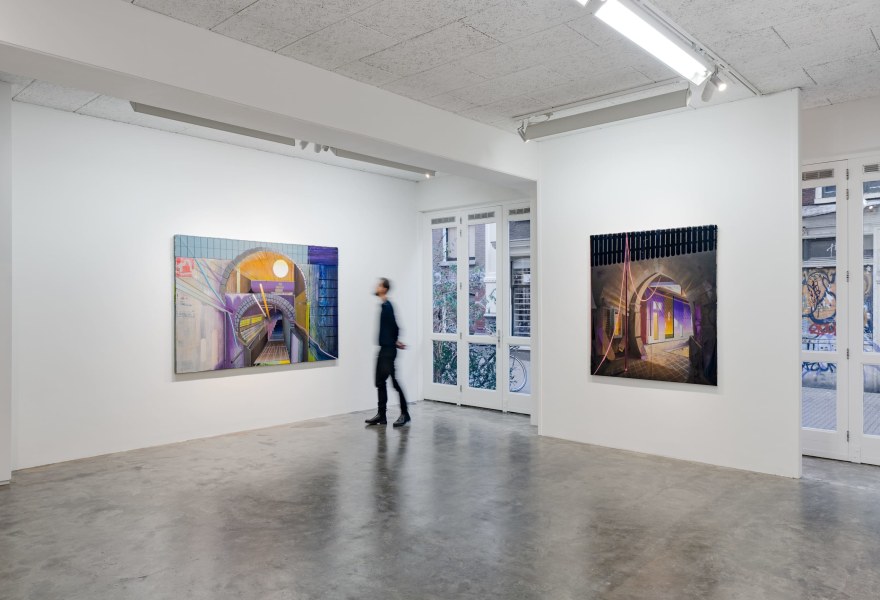31 january 2025, Flor Linckens
Christian Hellmich: space, time and memory in paint
The paintings of Christian Hellmich open up a world where architecture and memory seamlessly merge. In 'Fringe', his latest solo exhibition at Rutger Brandt Gallery, the German artist explores the fringes of Berlin — a cityscape where the past lingers in crumbling facades, vacant in-between spaces, and unfinished structures. In his work, seemingly inconspicuous elements — a forgotten staircase, a weathered awning, an anonymous façade — are imbued with new significance. They appear poised to reveal something yet remain suspended in an elusive state of transition. His paintings prompt questions about how we experience architecture, how memories take root in our surroundings, and how urban space is in a constant state of flux. Architectural forms dissolve into fragmented compositions of time, space and perspective.
The works in 'Fringe' depict an urban landscape devoid of human presence. Yet their absence is keenly felt: Hellmich’s compositions suggest spaces where something has occurred, though the nature of these past events remains ambiguous. At the same time, his paintings exude a distinct vitality — a playful tension between abstraction and recognisable forms. His work explores how architecture preserves memory and how spaces shape our collective consciousness.
In 2006, The New York Times art critic Ken Johnson wrote: “[The work of Hellmich] evoke[s] a nostalgic mourning for the undelivered promises of modernity and for the unrealized possibilities of collective public life.” The New Yorker noted in 2010 that “Hellmich has a franchise in architecture-derived complexities of zippy hard edges, delicately distressed surfaces, and daydreamily sweet and acrid colors. The pictures’ off-kilter rumpuses make you want to comprehend them. Fat chance. Negotiating Hellmich’s decisive disorder is like clambering around a construction site in an earthquake.”
Hellmich’s distinctive painting style blends geometric structures with expressive brushwork. His buildings and interiors seem perpetually unfinished, like construction sites caught in an endless state of transition. In his hands, painting becomes almost a method of organising forms and defining proportion.
His process begins with an intuitive, chaotic interplay of colours and shapes, gradually giving rise to architectural structures. He starts with free, expressive brushstrokes, layering his compositions step by step, constantly adjusting and reshaping. Forms shift in position, subtly dissolving into the background or emerging into the foreground. Architectural elements — half real, half imagined — materialise, only to be partially obscured or redefined. The artist employs a grid-like structure where fragments of buildings, shadowed passageways and weathered façades overlap. His practice aligns with the resurgence of modernist representational painting associated with the Neue Leipziger Schule.
Hellmich’s paintings exude a sense of timelessness, as though they encapsulate multiple layers of history — much like a city that continuously rewrites itself. His palette combines muted gray tones associated with contemporary urban environments, nostalgic pastels and striking accents in purple, orange, yellow and hot pink.
His inspirations are diverse. He gathers imagery from visual culture — magazines, postcards, and the internet — transforming them into paintings that reflect on how we consume images. His childhood memories also play a role, particularly his experiences of Stadtranderholung: urban summer camps designed for children from lower-income families, for whom the city’s outskirts became sites of recreation and escape.
In an era dominated by digital media, Hellmich’s work offers a counterpoint, a physical, tactile exploration of how we experience space and time. The paintings in this exhibition reveal that the edges of a city are not merely physical boundaries but also mental landscapes where memory and imagination intertwine.
Christian Hellmich was orn in Düsseldorf in 1977. He studied painting and visual arts at the Folkwangschule in Essen and currently lives and works in Berlin. His work has been exhibited at institutions including the Von der Heydt-Kunsthalle, Museum Folkwang, Kunstmuseum Bochum, the Mannheimer Kunstverein, Lehmann Maupin Gallery and the Hudson Valley Center for Contemporary Art. He has also published several artist books, including Tivoli, released by KERBER VERLAG.



